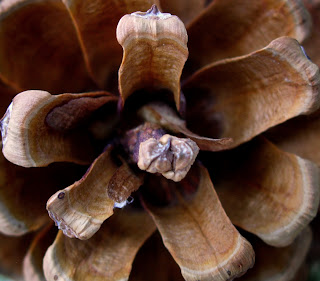
I liked this photo because it's a different view of a pine cone than you usually see. I was trying to make it resemble a flower. I was at Zimmerman Park when I took the shot and used the macro setting on my camera. I cropped it down to cut out some distracting elements in the corners and I also used a gradient filter in the corners to darken the bright spots. I darkened the overall image by adjusting the histogram and I used a warming filter to bring out the oranges and yellows of the pine cone. I wish that the foremost part of the cone was more in focus, but I'm generally happy with how it came out.
I shot this dead yucca plant with my macro setting at Zimmerman Park. It's a color photo but naturally looks black and white, which I liked. I also like the abstract design and detail of the fibers in the image. I adjusted the histogram to bring out more detail and used a warming filter on this image, but that's it. I am happy with how it turned out I just wish I could have taken a longer exposure to capture some of the detail that got blurred.
This is my favorite image that I took this semester. I love the color of the rose and the detail in the petals and water drops. This was on Rocky's Campus in front of the Eaton Administration building. I used the macro setting on my camera and cropped in on the rose when editing. I also used a gradient filter on everything but the rose petals. I adjusted the histogram to bring out detail and I saturated the red a little so that it would pop more. I wish I had a nicer camera so I could have blurred the background out more but other than that I really like this image.
I liked this photo because I thought it was a privilege to see so many pronghorn together. Apart from the bison in Yellowstone I've never seen such a large herd of ungulates. I was on the Rim Country Institutes land and used the landscape setting on my camera. I cropped in on the herd when editing and used a gradient filter on the top and on the bottom to darken those areas. I also adjusted the histogram which helped bring out more detail in the pronghorns. I used a warming filter which I thought went well with the color of the fur, grass and rock. I again wish I had a nicer camera with a telephoto lens, so I could zoom in closer to the animals and get a more intimate shot. I also wish my camera had better photo quality because cropping in as much as I did created some noise that I wish wasn't there.
This was probably my second favorite photo that I took over the semester. This was at a campground on the way to Yellowstone in the Beartooth Pass. I used my landscape setting and a gradient filter on the sky. I did some adjusting to the histogram as well. I used the clone tool quite a bit on this photo. I cropped in to cut out some of the plants and distracting elements on the bottom of the image but I didn't want to crop anymore than I did so I was obliged to remove some leaves, twigs and a post from the bottom of the image. I love the reflection but I wish it was more clear. I also wish I was capable of taking a longer exposure to capture some more detail in the distance.



























